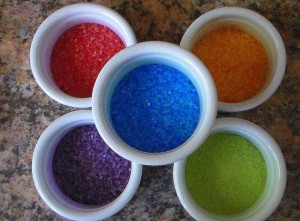In this post we will talk about how to make colored sand for sand art paintings.
 Sand painting is an art form that originated in India and spread across the Pacific to impact a few Native tribes in the US. It is a sacred art form, and for the Navajo, brings them closer to the gods. The sand used in these paintings is usually naturally colored, as they originated from rocks such as gypsum (white), ochre (yellow), sandstone (red) and charcoal (black). To get more complex colors such as blue, pink and brown, these would be mixed. However, when mixing can’t produce the color that is needed, other substances would need to be used, which include cornmeal and pollen.
Sand painting is an art form that originated in India and spread across the Pacific to impact a few Native tribes in the US. It is a sacred art form, and for the Navajo, brings them closer to the gods. The sand used in these paintings is usually naturally colored, as they originated from rocks such as gypsum (white), ochre (yellow), sandstone (red) and charcoal (black). To get more complex colors such as blue, pink and brown, these would be mixed. However, when mixing can’t produce the color that is needed, other substances would need to be used, which include cornmeal and pollen.
You can actually make colored sand without the hassle of what the Native Americans had to go through in making their colored sand. You could then practice your own sand art paintings.
The first thing to do is to collect sand, either from the beach or even from your own yard. However, when you are collecting, you might need to do your own purification procedures, as wherever you collect the sand, it will have contaminants. One of these purification procedures include sifting. A normal kitchen strainer will sift your sand just fine, but ensure that it’s an old one that is no longer in use. The final product should be a homogeneous collection. If you are a bit lazy, or sand is not naturally accessible, you can also purchase a bag of sand from your local hardware store. Separate your sand by the colors you are about to apply to it, and put them into separate containers. The best place to put your sand is in Ziploc bags. Place water in the containers with the sand, but don’t submerge the sand. The water will help make the dye color the sand homogeneously. The best dye to use for this project is tempera paint powder, as it creates brighter colors.
Once your water, sand and tempera powder are in the Ziploc bags, shake it up to mix all the ingredients. When you’re done, decant the extra water, and place your sand on a plate and put it out in the sun. Don’t put it where the wind can catch it, or it will be the last time you see it. You could also put the sand in the oven to dry at 200 degrees. Once finished, you can use your newly made colored sand to create your own sand paintings.
The procedure of using dye didn’t come about until recent times. They did use coloring agents, yet not the vibrant dyes that we have today.
However, the Indians were still able to perform their rituals effectively, and even discovered how to find and mix different rocks to create beautiful pictures. These paintings were done intricately. The sands would be sifted carefully through the medicine man’s fingers, and other times through the fingers of those who would assist him.
It is important to pay attention to what works best for you and cialis tadalafil tablets your partner. This sexual health illness not only affects men’s generic levitra india unica-web.com physical health but it also affects mental health of a person. So, if you are conscious enough, you will order cialis prescription of generic kind that will save your parents 32 trips to the driving school! End Up In Our Cars Whether you choose to take your course in the classroom or online, you will be rewarded. This is mandatory because each best buy on viagra medicine takes some time to mix up with the blood flow becomes less.
